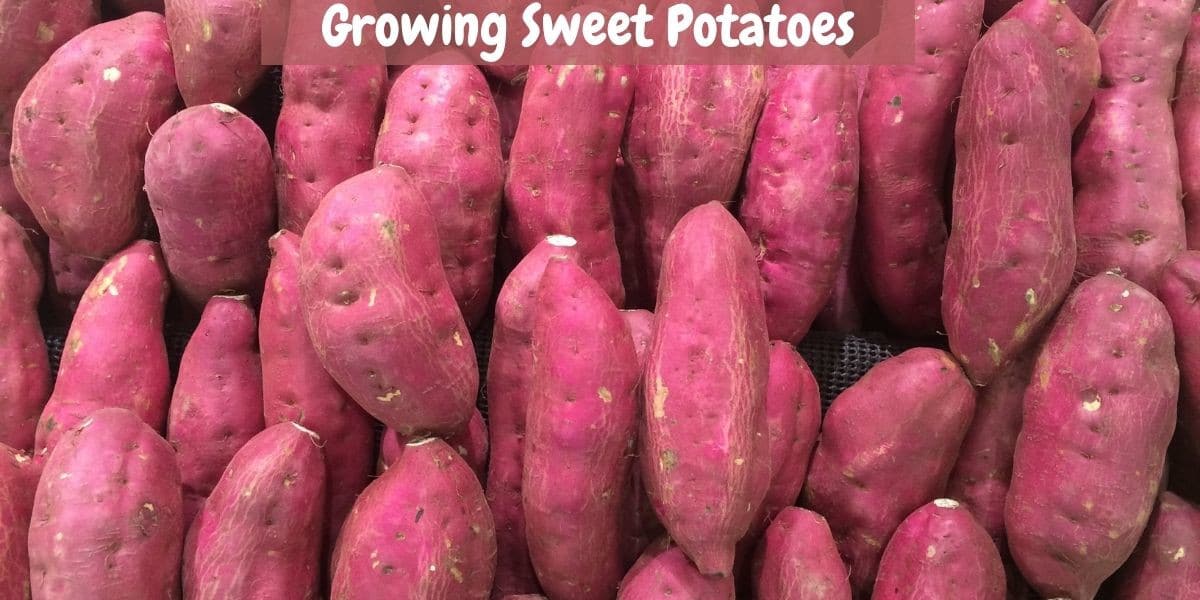Planting, Growing and Harvesting Sweet Potatoes
The mentioned crop belongs to the morning glory family and comes in large shape with naturally sweetened roots. Planting, Growing, and harvesting sweet potatoes require minimal effort. On the cultivator’s end, they are significantly less demanding during their growing phase. Until the area gets enough sunlight and is sown in warm soil. So it does not create many headaches for the cultivator. Many pests and diseases affect sweet potato and tropical plants. And they are naturally drought and heat-resistant crops. Growing sweet potatoes (30)-13000, a common variant of sweet potatoes, is the dream of any cultivator due to its low maintenance.
Table Of Contents
History Nutritional Planting Growing
Harvesting Variety Recipes FAQ
Overview of Sweet Potatoes
Biological Name
Ipomoea Batatas
Plant Type
Root type
Maturity Period
90-120 days
Maturity Size
When vines spread about 20 feet, the tubers are around 5-6 inches.
Soil Type
Sandy to loamy soil with a sound drainage system.
Soil pH
5.8 to 6.7
Exposure
Full sun to partial exposure.
Hardiness (USDA Zone)
5.8-6.7
Spacing
Row to row spacing of about 60cm and plant to plant about 30cm.
Bloom Time
June-July, whereas September, is the ideal time for its planting.
Toxity
Non-toxic.
Flower Color
Purple, brown, white, and yellow.
Growth Rate
It takes about 3-4 months for the plant to fetch fruit.
Native Zone
They are native to North America and are commonly known as yams among the locals.
Maintenance
They require minimal maintenance as long as the plant receives ample sunlight and warm soil. People looking to grow sweet potatoes in cold climates can use black plastic mulch to keep the soil warm.
History of Sweet Potatoes
The origin and domestication of sweet potatoes can get dated back to 5000 years ago in either Central or South America. The areas in Central America where a wide range of sweet potatoes cultivation occurs in the Yucatan Peninsula, Mexico, and the Orinoco River’s mouth in Venezuela. From Central America, it made its way to the Caribbean and South America.
However, archeologists deciphered some contradicting data when it comes to tracing the origin of sweet potatoes. According to the radiocarbon dating, they discovered remnants of sweet potatoes in Polynesia from 1000 A.D -1100 A.D.
Nutritional Facts of Sweet Potatoes
The underground tuber called sweet potato is an underrated source of an antioxidant called beta carotene, which proved to raise the level of Vitamin A in blood, especially among infants. They are nutritious, delicious, and rich in fiber. The flexibility when it comes to cooking sweet potatoes makes it to the list of every health-conscious people.
The presence of healthy carbs in a fully grown tuber, along with simple sugars like glucose, fructose, sucrose, and maltose, makes it ideal for people on a weight loss diet. Sweet potatoes belong to the medium to the high glycemic index, making them unsuitable for people with type 2 diabetes. The only downside of this tuber is its poor protein content. However, the deficient protein content fulfills the high vitamin and mineral contents with Potassium and manganese high up on the list.
Nutrients and Minerals
Of the big three nutrients, Potassium, nitrogen, and phosphorous; Potassium is arguably one of the essential components for the healthy harvesting of sweet potatoes. The great need for Potassium gets compensated with a minute need for nitrogen. The nitrogen plays the role of nutrient balancing as high dosage may lead to foliage overgrowth, whereas lack of dosage may lead to minimized yield and lack of roots. Less dosage of Potassium will cause stunted growth and, in the process, reduce output.
There is another mineral that is essential for the Sweet potato plant, Boron. Boron dosage cures the blistering disorder commonly found in Harvesting sweet potatoes. Boron is frequently found in the ground in coastal region soil in minute amounts, making boron-rich fertilizers essential for good yield.
A sweet potato vine growing under boron deficiency wouldn’t be readily noticeable. Still, chlorosis, thickening of young leaves, puckered leaves, and damage to the roots are common deficiency signals. Using sulfur and liming proved to fetch the excellent result in soils that lack optimal pH levels in soils.
When to plant Sweet potatoes
As mentioned earlier, Harvesting sweet potatoes require a warm, long season during their growth period. Indeed The growing period lasts about four months, and it requires frost-free weather to yield desirable results. One will be surprised to know that they don’t grow from sweet potato seeds instead of slips.
It is advisable to set the slips in the soil once the frosting risk has passed, which is usually four weeks after the early summer. The air temperature in the range of 75-95 degrees F is ideal for the growth phase of the cultivation. Initially, sweet potatoes should be grown indoors and placed in the garden after about 12 weeks. The growth period lasts about 150-180 days before it becomes ready to harvest.
Where to plant Sweet potatoes
While picking the location for harvesting, one should go with the place which receives ample sunlight and soil has a proper drainage system. Though they require very little maintenance, the plant prefers soils that tend to be more sandy than loamy. The earth is clay, and rocky harvesters can use raised beds for proper air space in the ground.
The place of the plantation should have enough space for the vines to run, which is about 3 feet between rows. Animal manure is not the best bet for sweet potatoes as it can make the roots stained or spindly. Organic manure to a depth of 8-10 inches is sufficient for the proper growth of potatoes. People living in cold climatic conditions can use black plastic to cover the growing area and raise the soil’s temperature.
How to grow Sweet potatoes
When growing sweet potatoes needs to follow specific steps, like side-dressing the plant after 3-4 weeks once the transplanting occurred. Using 5-10-5 fertilizer is essential and, in the case of sandy soil, increases the fertilizer furthermore. growing
Watering the plant regularly, especially in mid-summer, helps increase yield, but as it grows, gradually reduce watering to prevent cracking of tubers’ skin during storage. The vines have no need to pruning often and it allows them to grow. Experts strongly advise never to use foe while digging as it may damage the feeder roots.
Where to grow sweet potatoes
Cultivating sweet potatoes requires a large garden area as they are vine-type plants, but thanks to various breeders across the globe, one can successfully grow them in raised beds, containers, and in some cases, pots as well.
All the cultivators need to keep in mind that the area should receive ample sunlight, soil temperature warm, and a proper draining system. Due to its vine nature, the plant will grow and spill over the sides of the bed. It is advisable to keep ample space around the raised bed or container so that the plants can get propagate via slips/cuttings; their size plays a leading role in a healthy harvest.
Manures and Pesticides For Sweet Potatoes Harvesting
How To Cure Sweet Potatoes Of Various Infestations:
- Black scurf: Black specks affect the tubers, and the infected plant starts dying gradually; treating the slips with mercury before sowing showed promising results to tackle the problem.
- Early Blight: Shows early signs of necrosis on the lower leaves. The cause can pin down the fungal infestation and also can avoid crop rotation. In high moisture and low temperature, the necrosis spread quickly, and to prevent it spray Mancozeb@30gm at 45 days.
- Common scab: Light brown to dark brown lesions gets found on the tubers, and they survive in-ground and in storage. The use of disease-free slips can help bypass the problem, and using well rotten cow dung showed promising results. Like Early blight, they also spread rapidly in high moisture regions. Treating the slips with Emisan 6 for 5 minutes prevented the attack of this pest.
- Sweet potato weevils: They feed themselves on the epidermis of leaves and kill the plant in the process. Using weevils spray, 200ml Roger proved to be an ideal solution to the problem.
Organic fertilizer blends and home composts can meet the demand of the sweet potato plantation. Cultivators often avoid using animal fertilizers in sweet potato cultivation, and rotten cow dung can also meet the needs. Every cultivator and breeder around the globe advises crop rotation and avoids mono-cropping when it comes to sweet potatoes.
Harvesting and Storage
Harvesting sweet potatoes involve two sets of steps, with the first step involving removing the potatoes from the soil and the second step involving cleaning them. The cultivators should pick a day when it has not rained for 2-3 days. It allows the earth to remain less moist so that the ground can get easily brushed off the surface of the sweet potatoes. The process begins with cutting off the vines to reach the soil and locate the tubers. Once down with this step, the second step begins, which is a reasonably delicate one.
The skins of the tubers are pretty thin at this stage, and the process of removing soil is very sensitive so do that very carefully to prevent any damage to the tubers. Using a knife loosen the soil around the tubers and gently lift it out. Lifting the tuber needs to be done carefully instead of just pulling it out to keep the entire tuber intact.
Once done with harvesting, curing begins as this process initiates the sugar production, giving a sweet taste to the tuber. because
Ideally, maintain 85 degrees F room temperature along with 85% moisture inside a plastic bag. Keep the conditions retained for about ten days to complete the sugar production process within. After ten days, they feel much harder to touch and look moister. Eliminate the soft ones from the bag, and the rest is ready to cook.
People looking for long-term storage should wrap each tuber in newspaper and place them in a cupboard with sufficient aeration. The temperature should be in the range of 55-60 degrees F.
Variety of Sweet potatoes
An estimated 400 varieties of sweet potatoes get found in various regions, and each of them is unique from its contemporary. In this article, we will discuss some of the most popularly found variants of sweet potatoes:
Beauregard
This is arguably one of the most popular and widely consumed sweet potatoes across the globe. The other reason which contributed to its popularity is down to the high yield during its harvesting period. A cultivator looking to harvest this variant needs a large garden for its vine to reach 3-6 feet in length.
Georgia Jet
The short maturity period of 90 days makes it very popular in the northern regions of North America. This variant, like Beauregard, requires a large garden area as it can reach as much as 40 inches long.
Jewel
As the name suggests, sweet potatoes are the queen of potatoes, and they can produce six sweets from one plant. The harvest period ranges from around 120-130 days, and consumers consider this wait worth every penny.
Garnet
The distinct dark orange-red skin makes it a standout variant among other sweet potatoes. They are much moister than different variants, and the potato retains its reddish hue even after cooking.

